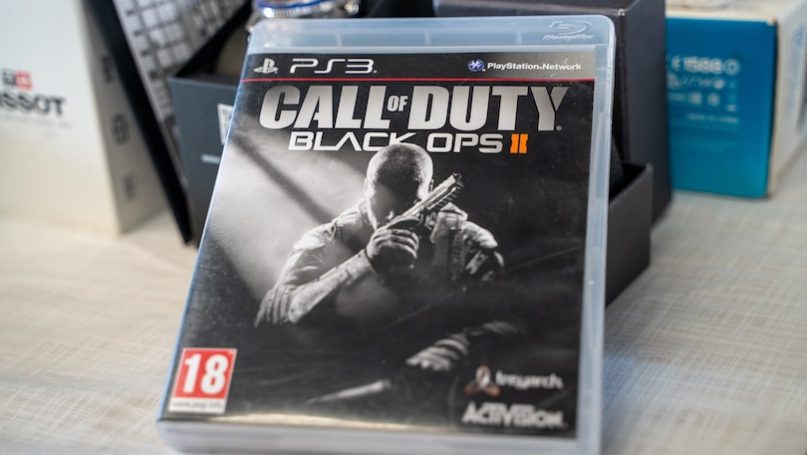
Erman Gunes/Shutterstock
Activision’s Call of Duty: Black Ops 2, a fan beloved classic for its gameplay, may now also be worth remembering due to the connections in its sci-fi plot and our reality. In the game’s version of 2025, “Cold War II” is well underway as technological advancement increases exponentially, creating national security vulnerabilities and a fearful world. In global politics, great power competition has ramped-up where countries return to brinkmanship, putting America and the world at eschatological risk. There are many story lines and concepts at the strategic, operational, and tactical levels of war that are unrealistic. Many futuristic technologies remain theoretical such as robot autonomous armored vehicles and invisibility. Not to mention, notable cameos and political forecasting which includes Retired US Army General David Patreaus as the Secretary of Defense who subtlety quips smack talk to a captured terrorist on the USS Barack Obama. Yet beyond these, there are three core concepts in the story that should eerily draw comparison to today.
The first is the “Strategic Defense Coalition” (SDC), a Chinese lead multilateral alliance hell-bent on global dominance, economic resource control and strategic competition with the West. Depending on the player’s critical choices throughout his or her missions, Russia, Iran, and even India may join Beijing’s alliance. SDC’s dominance results from Beijing’s mastery to persuade or coerce near-aboard countries such as North Korea, Pakistan, Burma (Myanmar), and Afghanistan as an inevitable super-power with all means necessary. China is not so much a stereotypical James Bond or Rocky film communist antagonist, rather an anti-Western geopolitical competitor with control over vital rare earth minerals and mercantilist wealth. A terrorist enabled hack of the Chinese stock market and subsequent crash leads Beijing to cut rare earth element exports with the US. The story reveals the terrorist is motivated to cause war between the US and NATO against China and the SDC, leading to a new world order.
In our reality, many are calling this era of international relations a New Cold War. Economically, China is the #1 trading partner with over 60% of all nations. Since the video game was made 12 years ago, China and Russia jointly decreed their partnership had “no limits” and planned to expand on all fields from civilian to military. As recently as September, China has made a “substantial effort” through underground aid to “build and diversify various elements of the Russian war machine,” according to the US Deputy Secretary of State Kurt Campbell. Iran and North Korea have also surged beyond their regional influence as key military suppliers for Moscow’s war in Ukraine. Meanwhile, while India and China continue to have their own geopolitical tension, New Delhi still emphasizes BRICS and stands to benefit from a multipolar international system.
And who can forget China’s Belt and Road Initiative, which has subsequently allowed Beijing access to some of the world’s best places for rare earth mineral extraction? One major reason why American support for Taiwan is collectively justified in domestic political forums is due to Taiwan’s robust microchip manufacturing. According to an assessment by the Armed Forces Communications & Electronics Association International, “Semiconductors directly require silicon, iridium, boron and phosphorus; rare earths involved are germanium and gallium. China accounts for 98% of global raw gallium production and 67 percent of raw germanium production.”
The implications for increased friction in great power competition mean a bevy of conflicts for Washington, including: (1) a proxy war with Russia, the world’s largest holder of nuclear weapons, (2) a shadow war with Iran and the Axis of Resistance, which has negatively altered global shipping and trade and (3) a cold conflict with China over the status of the South China Sea and Taiwan. These strategic issues neglect other ones with direct American involvement such as the Korean Peninsula standoff and north-eastern Syria Kurdish nation-building project. Yet all of the aforementioned also neglect the US-Mexico border crisis, a national security threat increasingly and arguably, most directly, impacting average American lives.
Does the fictional 2025 geopolitical situation and our strategic analysis of the world correlate? Not necessarily. Thematically consistent? Absolutely. It is rational to conclude in our global geopolitical reality that America’s adversaries, many non-aligned nations, and perhaps some partners are fed-up with the US-led world order while the most hostile are actively seeking to end it. The question is: replace the American dominate system with what? A China-dominate system, multipolarity, or something else? For now at least, we must accept that America’s adversaries are cooperating at levels not seen since before the Sino-Soviet Split.
The second consistent theme throughout the game occurs at the operational level of war, where military and civilian reliance on technology is confirmed as a vulnerable Achilles Heel. Near the game’s conclusion, the terrorist creates a trap for our heroic protagonists by his capture. He is brought to interrogation and successfully uses an insider agent to free himself and hijack the USS Barack Obama. Through MacGuffin technology, he is able to hack into all US Military drones and missiles, launching them to Beijing, Shanghai, Hong Kong, and Los Angeles. Of course, the plot is fantasy written by developers who want to place the player in familiar places, such as Downtown LA. However, the average American Call of Duty player and non-player should be aware that cyber warfare is a viable option for state or non-state actors to achieve their goals. The question is, however, goals for who and what purpose?
The terrifying reality is that cyber-attacks are often unattributable to an actor (or multiple actors in as centralized or decentralized operations). Black Ops 2’s hacker was obviously a terrorist who thirsted for World War III between the West and the rest. Yet if there is a significant cyber-attack in real life, we may never know the motivation or the actor. This may lead to greater crisis and possibly war with already established adversarial powers. The lesson Black Ops 2 thematically argues is that there are no impregnable measures for cyber vulnerabilities. Furthermore, how a rapid pace of escalation between two great powers previously in crisis can escalate to war. There is even a non-playable scene where the Chinese President is angry at the US President for “attacking” China as American drones and missiles approach.
The third thematic consistency from the game is that information warfare is just as powerful as the larger-than-life weapons the player gets to control. According to Forbes, the average person is exposed to 6,000 to 10,000 advertisements in a single day, that’s 2 million on the lower estimate per year. Advertisements are effective at targeting our subconscious. Social media algorithms manipulate us to keep scrolling. Almost everyone in our society agrees about these ideas across the political spectrum.
So, how does a person consider supporting and even assisting a nihilistic mass murdering terrorist? In Black Ops 2, the terrorist finds success using propaganda to disaffected persons due to the political, military, and economic effects of Cold War II across NATO, SDC, and non-aligned countries. His recruiting mechanisms through social media platforms may be scoffed by some, and granted, it is fair to criticize this as unplausible. However, the brutal reality is that all of us are targeted by information for various purposes, nefarious or otherwise. While it may appear silly to watch a fictious advertisement to join the evil “Cordis Die” in Black Ops 2, the game is reminding us of our luxury and freedom to study real history and analyze how masses fell to radicalism such as the Nazi and Bolshevik movements.
The player’s decisions throughout the game affect the plot either averting or enabling Cold War II’s escalation to Armageddon. Likewise, and with a pen, not a weapon, Americans will decide in November. Voters should consider the consequences of American foreign policy interventions as great power competition, technological advancement, and information warfare only increase. The 47th American President will certainly have many challenges ahead. Yet in the meantime, maybe we should go back to this game to reflect and discuss the 2025 geopolitical reality we do not want.
Further Reading on E-International Relations
About The Author(s)
Jack Dulgarian is a professional analyst and consultant working in national security and defense. He has previously written on issues regarding the near east and eastern Europe. In 2023, he authored an analysis scenario-casting how Russia would thwart Armenia’s security prior to the fall and ethnic cleansing of Nagorno-Karabakh. He has been referenced by National Defense University’s Joint Quarterly Magazine and given lectures to the State Department’s Foreign Service Institute. The views herein are this author’s only.
Before you download your free e-book, please consider donating to support open access publishing.
E-IR is an independent non-profit publisher run by an all volunteer team. Your donations allow us to invest in new open access titles and pay our bandwidth bills to ensure we keep our existing titles free to view. Any amount, in any currency, is appreciated. Many thanks!
Donations are voluntary and not required to download the e-book - your link to download is below.

 Movie
Movie 2 months ago
37
2 months ago
37 






![Presidents Day Weekend Car Sales [2021 Edition] Presidents Day Weekend Car Sales [2021 Edition]](https://www.findthebestcarprice.com/wp-content/uploads/Presidents-Day-Weekend-car-sales.jpg)



 English (United States)
English (United States)